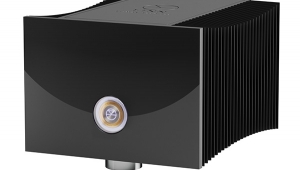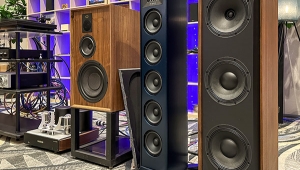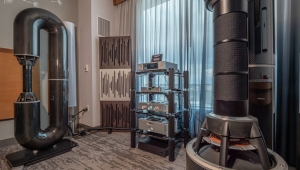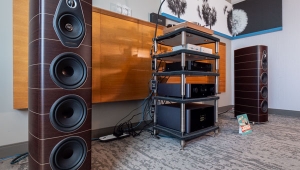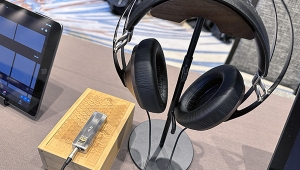| Columns Retired Columns & Blogs |
Arcam Solo CD receiver Measurements
Sidebar 3: Measurements
Looking first at the performance of the Arcam Solo's CD section, assessed at the Preamplifier Out jacks, this offered a maximum level of 1.965V with the volume control set to "72." Signal polarity was preserved; ie, the output was noninverting. Error correction, assessed using the Pierre Verany test CD and both listening to the signal and looking at the error flag in the digital output signal, was astonishingly good, the Solo handling gaps in the CD data spiral up to 2mm long without errors, and up to 3mm long without audible glitches.
CD frequency response featured a slight loss of energy in the top octaves (fig.1, top pair of traces), but there was no de-emphasis error other than that (fig.1, bottom traces). Channel separation, again assessed at the preamp outputs (not shown), was better than 85dB in the midrange, but decreased somewhat at high frequencies due to the usual capacitive coupling between channels.

Fig.1 Arcam Solo, CD frequency response at –12dBFS into 100k ohms, with de-emphasis (bottom) and without (top). (Right channel dashed, 0.5dB/vertical div.)
One-third–octave spectral analysis of the CD section's output while it decoded data representing a dithered tone at –90dBFS (fig.2) showed a clean noise floor unbroken by power-supply or harmonic spuriae. The peak representing the tone peaked at exactly –90dBFS in this graph, suggesting excellent DAC performance, which was confirmed by the plot of the linearity error with decreasing signal level (fig.3). In fact, the noise shown in these two graphs is basically that of the dither recorded on the CD, meaning that the noise floor of the Arcam's replay circuitry is below that of the CD. That this is the case is demonstrated by the Solo's reproduction of an undithered sinewave at exactly –90.31dBFS (fig.4). The three voltage levels that describe this signal are clearly evident, with good waveform symmetry and low noise.

Fig.2 Arcam Solo, 1/3-octave spectrum of dithered 1kHz tone at –90dBFS, with noise and spuriae, 16-bit CD data (right channel dashed).

Fig.3 Arcam Solo, departure from linearity, 16-bit CD data (2dB/vertical div.).

Fig.4 Arcam Solo, waveform of undithered 1kHz sinewave at –90.31dBFS, 16-bit CD data.
Distortion levels for CD playback were low, with the second harmonic the highest in level, at –77dB (0.014%). Intermodulation distortion was similarly low, with the 1kHz difference component resulting from an equal mix of 19 and 20kHz tones, each at –6dBFS, lying at –84dB (0.005%).
Fig.5 shows a narrowband spectral analysis of the Solo's analog preamp output signal while it played CD data representing a high-level tone at exactly one quarter the sample rate, overlaid with a low-frequency squarewave at the LSB level. Sidebands around the spectral peak can be due to a number of mechanisms, the primary of which will be word-clock jitter. The Miller Audio Research Jitter Analyzer finds these sideband pairs and calculates a weighted sum: that for the Solo was 306 picoseconds peak–peak, which is low. One pair of sidebands at –229Hz, marked in red, results from the squarewave (the other sidebands indicated in red are at the residual level in the signal), but the main sources of jitter energy, indicated with purple numeric markers, are unknown in origin.

Fig.5 Arcam Solo, high-resolution jitter spectrum of analog signal at preamp output (11.025kHz at –6dBFS sampled at 44.1kHz with LSB toggled at 229Hz). Center frequency of trace, 11.025kHz; frequency range, ±3.5kHz.
The Solo's preamplifier output featured a fairly low source impedance of 475 ohms and a wide bandwidth; the response for analog input signals with the tone controls set to flat featured a –3dB frequency of 190kHz. The volume control operated in 1dB steps; with this set to its maximum level of "72," the preamplifier output was just 0.2dB below unity gain. The input impedance for analog signals was 43k ohms in the bass and midrange, dropping to 36k ohms at 20kHz, which is still usefully high.
Looking at the Solo as an integrated amplifier, it offered a maximum voltage gain of 31.2dB into 8 ohms and didn't invert signal polarity. Channel separation at 100Hz was 95dB L–R and 85dB R–L, this decreasing with increasing frequency to 48dB/58dB at 10kHz, due to capacitive coupling between the channels. The A-weighted signal/noise ratio (ref. 1W into 8 ohms with the volume control at "72" and the input shorted) was excellent at 90dB, though it did worsen to 71.4dB with a wideband, unweighted measurement.
The power-amplifier section's output impedance was just below 0.14 ohm at mid and low frequencies, rising slightly to 0.18 ohm at 20kHz. The modification of the Solo's frequency response due to the Ohm's Law interaction between its output impedance and that of the loudspeaker will therefore be modest, at around ±0.15dB (fig.6, top, solid trace). This response graph also shows the Solo's output into resistive loads ranging from 2 to 8 ohms. A small peak at 82kHz is more fully developed into the higher impedance, which correlates with a small degree of overshoot and some damped ringing on the receiver's reproduction of a 10kHz squarewave (fig.7).
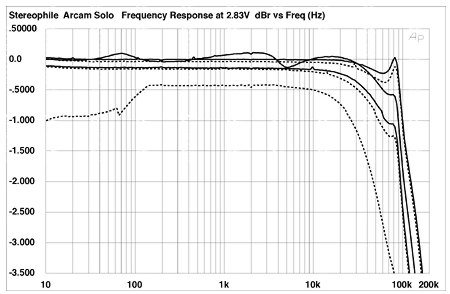
Fig.6 Arcam Solo, volume control at "72," frequency response at 2.83V into (from top to bottom at 2kHz): simulated loudspeaker load, 8 ohms, 4 ohms, 2 ohms (1dB/vertical div., right channel dashed).

Fig.7 Arcam Solo, small-signal 10kHz squarewave into 8 ohms.
Of more concern in fig.6 is the shelving down of the Solo's response at low frequencies into 2 ohms. Throughout the testing, the Arcam wasn't happy with load impedances below 4 ohms. This is apparent from the plots of its THD+noise percentage against output power (fig.8). Defining clipping as 1% THD+N, the Solo exceeds its specified power at 1kHz, delivering 69Wpc (18.4dBW) into 8 ohms and 81W (16.1dBW) into 4 ohms, both figures measured with both channels driven. However, just 8W were available into 2 ohms (3dBW), even with just one channel driven. And when I plotted its small-signal THD+N percentage against frequency (fig.9), the moderately low level of distortion into 8 and 4 ohms increased dramatically at low frequencies into 2 ohms, perhaps due to the Arcam's protection circuitry.
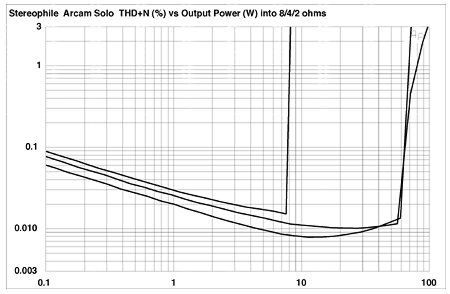
Fig.8 Arcam Solo, distortion (%) vs 1kHz continuous output power with (from bottom to top): two channels driven into 8 and 4 ohms, one channel driven into 2 ohms.

Fig.9 Arcam Solo, THD+N (%) vs frequency at 2.83V into (from bottom to top): 8 ohms, 4 ohms, 2 ohms (right channel dashed).
The protection circuitry was on the job when I attempted to precondition the Solo by running it at one-third power into 8 ohms for one hour. While the distortion didn't increase significantly, the amplifier turned itself off after 15 minutes, the external heatsink too hot to touch, and even the top panel adjacent to the heatsink at around 55ºC. No damage was done, however, and I could turn on the amplifier again after a few minutes' cooldown. But the Solo does run hot, and should be given plenty of space for ventilation.
Returning to harmonic distortion, this was predominantly the subjectively benign second harmonic at fairly low levels (fig.10), though the third harmonic became dominant at levels close to clipping. In addition, some high-order spikes at the zero-crossing points became apparent into loads below 8 ohms (fig.11), though the absolute level of the THD remained low. Intermodulation distortion was also relatively low, even close to the amplifier's clipping power (fig.12).

Fig.10 Arcam Solo, spectrum of 50Hz sinewave, DC–1kHz, at 16W into 4 ohms (linear frequency scale).
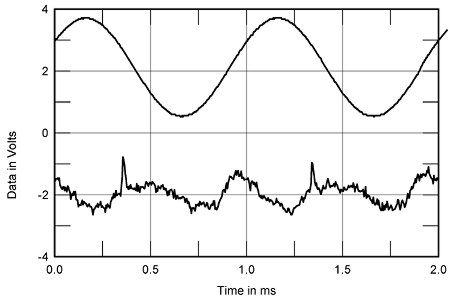
Fig.11 Arcam Solo, 1kHz waveform at 7W into 4 ohms (top), 0.011% THD+N; distortion and noise waveform with fundamental notched out (bottom, not to scale).

Fig.12 Arcam Solo, HF intermodulation spectrum, DC–24kHz, 19+20kHz at 24W peak into 8 ohms (linear frequency scale).
Owners should steer clear of speakers with impedances that dip below 4 ohms, but with that proviso, the Arcam Solo delivers excellent measured performance, particularly from its CD section.—John Atkinson
- Log in or register to post comments
















